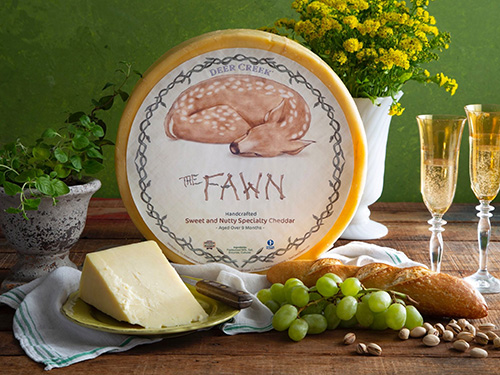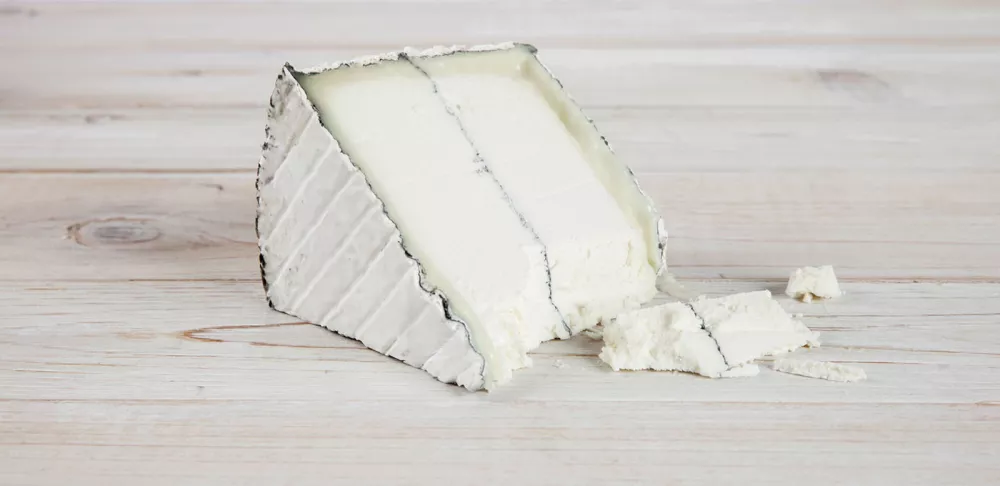Among the adjectives frequently used to describe cheese, “newsworthy” is not often in the usual lineup.
On an occasion when cheese is worthy of a national headline, however, there’s a great deal of unqualified excitement for those who make, sell or appreciate cheese. Such was the case earlier this month when First Lady Jill Biden and White House Executive Chef Cristeta Comerford conspired to serve a cheese course composed of three American cheeses at a state dinner honoring Emmanuel Macron, the President of France.
To put this in perspective, France’s cheesemaking history goes back several millennia, and French dairies or monasteries are credited with creating several styles of cheese — often by accident — which still exist today, such as bloomy rind (as in Brie,) washed rind and blue cheeses. While American cheese is currently enjoying a boom, with an estimated 1,000 producers of artisanal cheese now operating in the United States — along with an increase in quality and popularity of American artisanal cheeses — cheese in America has a history of less than 200 years, with the current artisanal movement only going back to the 1980s and 1990s.
For American turophiles, “domestic” cheese is often preferred terminology over “American” cheese, since the latter tends to conjure ideas of the individually-wrapped, “cheese product” slices that, while they have their uses, bear little resemblance to any cheese made of artisanal processes in the United States or elsewhere. Regardless of what you call it, however, the star is definitely rising for American cheese, so now’s a good time to get familiar with what American creameries are up to. With that, here’s a closer look at three newsworthy American cheeses fit to serve the President of France.
Cypress Grove Humboldt Fog
California’s Cypress Grove creamery is one of the oldest and most well-renowned in the American cheese industry, with founder Mary Keehn making artisanal, crowd-pleasing cheeses from her herd of goats since 1983. (It was a Cypress Grove cheese in fact, a goat gouda called Midnight Moon, that turned me on to fancy cheese in the first place.)
Keehn conceived Humboldt Fog in a dream, and indeed it has become her most legendary, and has doubtlessly inspired many a cheese dream since, tasting of buttermilk and crème fraîche, with herbal, floral and slightly earthy tones. There’s a lot to unpack just by looking at Humboldt Fog: a bright white paste, bisected by a racy stripe of vegetable ash, giving way to a nearly runny creamline, encased in a cake-like package with a lacy, bloomy rind.
Related Reading:5 Major Cheese Styles Every Chef Should Know
Humboldt Fog’s bright whiteness comes from its goat milk nature. Because of their active lifestyle, goats utilize the beta carotene from grass ingested to convert to vitamin A, whereas the relatively chill lifestyle of cows and sheep leave behind some beta carotene in their milk, giving a buttery or yellow hue to those cheeses. The gooey creamline develops because of its aging process: bloomy rind cheeses develop from the outside in, so while the center paste looks as bright and fresh as the day it was formed, the outer layer of the cheese closest to the rind exhibits the continual breakdown of protein and fat. The stripe of ash is actually an homage to a famous French cheese called Morbier. Ash was historically used in cheesemaking as a preservative, lowering the pH of animal milk and providing a protective layer until enough milk was collected to be used for cheesemaking. While this protective element is less relevant today, ash is still employed to temper the natural acid of goat cheeses, plus it offers an intriguing visual contrast that isn’t to be overlooked.

Deer Creek Cheese The Fawn Cheddar
You can hardly assemble an All-American cheese plate without including Wisconsin. In the trio of red, white and blue cheeses curated by the First Lady, this robust, Wisconsin cheddar represents the red, at least in contrast to the bright white of the Humboldt Fog, and the blue cheese to come. The Fawn is a young and mellow cheddar whose proprietary cocktail of cultures results in a complexity of flavor unique to a young cheese. Bandage-wrapping is common in cheddar cheeses to prevent much of a rind from developing, but that allows for a crumblier texture and a nuttier flavor than cheddars that are vacuum-sealed. Between the tang of Humboldt Fog, and the gentle sting of the Rogue River Blue to follow, The Fawn is a perfect counterpoint with its almost butterscotch look and flavor.
Related Reading:Understanding Cheddar
Wisconsin has long been known as the dairy state, and while it is still where a majority of commercially-produced cheese is made, Wisconsin cheesemakers have also risen to the occasion of the artisanal cheese movement. According to the story on their website, the people behind Deer Creek Cheese aren’t so much “cheesemakers” as “cheese hot-rodders,” taking traditional, time-honored recipes and continually asking, “what if?” Deer Creek Cheese was founded in 2006 by Chris Gentine, and his ethos has long been one of partnership. The Fawn was created as the first cheese in a lineup with Master Cheesemakers (Wisconsin being the only state to offer such an accreditation), with Kerry Henning of Henning’s cheese.
Rogue Creamery Rogue River Blue
If there was ever an American cheese to make not only national, but international headlines, it is this unique blue from Oregon’s Rogue Creamery, which has been in the American cheese game since 1933. Yearly, hundreds of cheese professionals from around the globe converge to taste and evaluate thousands of the world’s cheeses at a hallowed event known as the World Cheese Awards. After tabulation of scores and much discussion, a World’s Best Cheese is named, and 2019 was the first year in which an American cheese took that honor: Rogue Creamery’s Rogue River Blue. (If Franco-American relations could survive that moment in food history, the recent state dinner cheese plate was probably less of a big deal.)
What better cheese then, to put as a best-foot-forward when it comes to American cheesemaking? Rogue Creamery makes entirely blue and cheddar cheeses, applying different formulas and techniques to achieve unique results. Rogue River Blue is a seasonal cheese, appearing in monger’s cases around November in time for the holidays. (If you act quickly, you may still find some from this season.) The cow’s milk for Rogue River Blue is collected specifically in the fall, when cool and wet temperatures bring certain flora to the pastures, providing what the creamery feels is its best-flavored milk. After about a year of aging for the signature blue veins to develop, the cheese wheels are wrapped in Syrah leaves soaked with a local pear liqueur, helping to tease out the fruity and nutty notes of the cheese itself.






